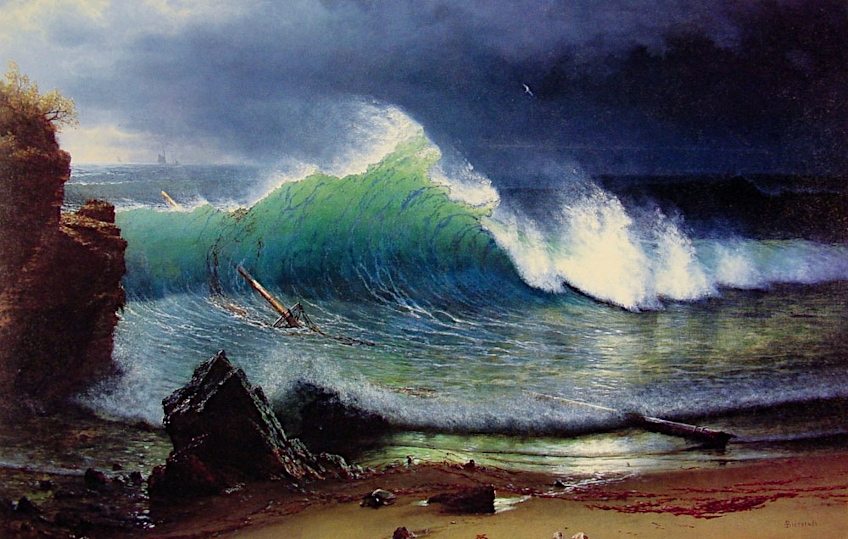Abhishek Kumar
JANUARY 07, ON THIS DAY
Christ is one with His creatures and so man must treat his fellow creatures as Christ would. The continual slaughter of native species must be halted before all is lost.
Albert Bierstadt

Albert Bierstadt was an influential American landscape painter who was known for his grand, sweeping views of the American West. Bierstadt’s work was highly influential in shaping popular perceptions of the American West and played a significant role in the development of the western landscape painting tradition in the United States. He was renowned for his detailed and realistic depictions of the American West, particularly the Rocky Mountains and the Sierra Nevada. He often set his paintings in the midst of vast, open landscapes, emphasizing the majesty and grandeur of nature. Bierstadt is considered one of the most influential painters of the Hudson River School, a group of landscape painters that flourished in the mid-19th century. His paintings have been described as some of the most powerful and dramatic of the time.
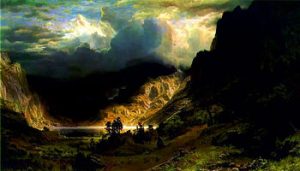
Bierstadt was born on January 7, 1830 in Solingen, Germany and immigrated to the United States at the age of two with his family. He settled in New Bedford, Massachusetts and then moved to New York City to further his artistic studies. He studied painting in Europe and the United States, and developed a style that combined elements of romanticism, realism, and luminism. His work was influenced by the natural beauty of the American West, and he was one of the first painters to depict the region in its grandeur. His early works were primarily of scenes on the East Coast, but after his travels to the American West in 1859, he began to focus on the landscapes of the region.
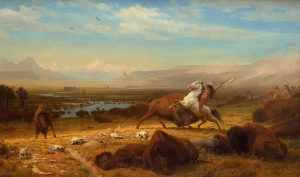
Bierstadt’s work is characterized by its dramatic and romantic portrayal of the natural landscape, often depicting the grandeur and beauty of the wilderness. In his paintings, nature often takes center stage, with towering mountains, cascading waterfalls, and sweeping vistas serving as the backdrop for the scenes he depicted. Bierstadt believed that nature was the ultimate source of beauty and inspiration, and this belief was reflected in his paintings. In his landscapes, Bierstadt often depicted serene, majestic landscapes filled with towering mountains and pristine forests. He also depicted scenes of human activity in nature, such as Indians hunting and fishing. By emphasizing the grandeur of nature, Bierstadt sought to inspire a sense of awe and wonder in the viewer. Nature was not only a source of beauty in Bierstadt’s paintings; it also served as a metaphor for American progress and Manifest Destiny. By portraying the West as an untamed but majestic wilderness, Bierstadt encouraged viewers to appreciate the natural beauty of the land and to be inspired by the possibilities of what could be achieved by settling and taming it.
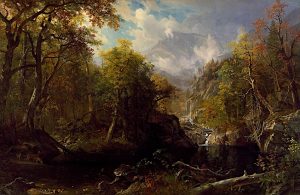
The role of nature in Bierstadt’s paintings was paramount. He believed that nature was a source of beauty and inspiration, and he sought to capture and convey its beauty in his work. Bierstadt was particularly drawn to the rugged, untamed landscapes of the West, which he saw as embodying the spirit of freedom, adventure, and exploration. He wanted to celebrate these places and share them with the world. To this end, Bierstadt often employed a range of techniques to emphasize the beauty of his subjects. He often used dramatic lighting and compositions to create a sense of awe and drama. He also used subtle hues and tones to evoke a sense of tranquility and peace. Ultimately, Bierstadt’s paintings serve as a reminder of the beauty and power of nature. His works provide a window into a world of untouched beauty and grandeur, and remind us of the importance of preserving and protecting our natural environment.
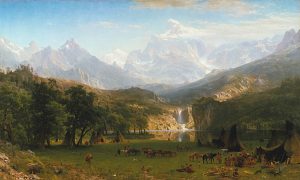
Bierstadt traveled extensively throughout the American West, making numerous sketching trips to the Rocky Mountains, Yosemite, and other western locations. He used these sketches as the basis for his large, highly detailed landscape paintings, which were popular with collectors in the late 19th century. Bierstadt’s work was influential in promoting the idea of the American West as a place of untamed beauty and grandeur. He died in 1902 at the age of 72. Bierstadt’s work has been praised for its attention to detail, stunning compositions, and ability to evoke emotion in the viewer. He is remembered as one of the most important landscape painters of the 19th century and an important figure in the development of American art.
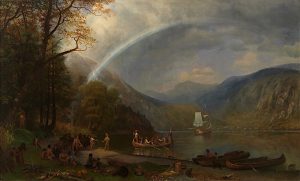
Sources:
- https://www.theartstory.org/artist/bierstadt-albert/
- https://www.thehistoryofart.org/albert-bierstadt/biography/
- https://www.newworldencyclopedia.org/entry/Albert_Bierstadt
- https://artincontext.org/albert-bierstadt/
- https://en.wikipedia.org/wiki/Albert_Bierstadt


